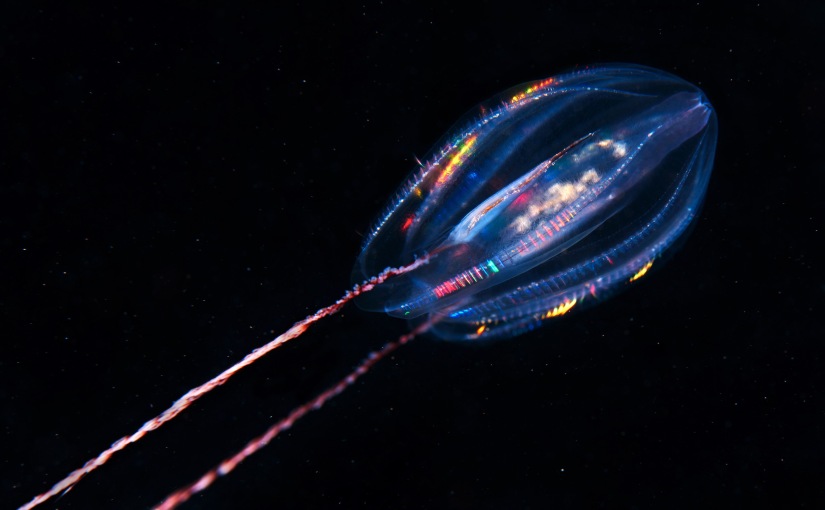Introduction
There are less than 200 known species of ctenophores, all of which are found exclusively in marine habitats. Ctenophores, more commonly known as the comb jellies, resemble cnidarian medusa (I will forgive you for confusing them with jellyfish), but ctenophores have a few specific features that make them unique.
Morphology
Opposed to jellyfish, who have radial symmetry, ctenophores have bilateral symmetry (Pang & Martindale, 2008). They don’t use jet propulsion like our Scyphozoan friends, but rather are the largest animals to swim with the help of cilia, with adults range from a few millimetres to 1.5 metres (Tamm, 2015). The cilia are packed in the thousands into ctenes, or comb plates, which are organised into comb rows around the body (Tamm, 2014).
Ctenophores are known to be bioluminescent, where the photoproteins, located in canals under the comb rows, are activated (Haddock & Case, 1999; Pang & Martindale, 2008). This is not to be confused with the rainbow effect of the comb rows produced as their cilia beat and scatter light (Welch, Vigneron, Lousse, & Parker, 2006).

Feeding
Ctenophores have sticky cells in the epidermis of their tentacles called colloblasts which capture food. The tentacles expand when ready to capture food and the branches on the tentacles separate. The stickiness of the colloblasts allows the organism to “fire” a fibre with adhesive granules to capture food (e.g., copepods).
Colloblasts are linked to a nervous system that triggers the retraction of the tentacles towards the mouth when prey is captured. Prey is then wiped inside the mouth, swallowed, and liquified into a slurry by enzymes and muscular contractions in the pharynx. Cilia beat and distribute the slurry through the canal system where digestion occurs intra and extracellularly. Some waste is released through the anal pores but usually they regurgitate waste from the mouth.
Colloblasts are unique to ctenophores and are found in the epidermis of the tentacles and, similar to nematocysts of Cnidaria, the colloblasts are discharged from the tentacles and capture prey (Franc, 1978). However, colloblasts are not venomous but rather they are adhesive and stick to their prey. The rare ctenophore, Haeckelia rubra, has rid itself of colloblasts completely and instead collects nematocysts from their cnidarian prey (Mills & Miller, 1984).
Nervous system and navigation
Ctenophores have a structure, know as the statocyst, that aids in their navigation and orientation through gravitational sensitivity (Pang & Martindale, 2008; Tamm, 2015). If a ctenophore is pulled off balance, its statocyst will direct beating of specific comb rows in order to right itself. For movement over long distances, ctenophores mainly rely on ocean currents (Pang & Martindale, 2008). Instead of a nervous system, ctenophores have a complex nerve net that works closely with the statocyst and ctenes (Pang & Martindale, 2008; Tamm, 2014; Tamm, 2015).
Reproduction
Floating somewhat aimlessly around in the ocean as a relatively tiny and hard-to-see individual means the likelihood of you meeting someone you can have babies with is quite low. To combat this, almost all ctenophores are self-fertile hermaphrodites (Pang & Martindale, 2008).
Classifications
Class Tentaculata
Tentaculata have, you guessed it, tentacles. Commonly, they have long, feathery tentacles which are equipped with colloblasts.

Class Nuda
If Class Tentaculata have tentacles, then Class Nuda must have no tentacles. Organisms from Nuda are known as beroids (from the monophyletic order Beroida), and they feed by using their large mouths to engulf prey. Alternatively, some species spread their lips over prey whilst a sword-like structure chops the prey up (Tamm & Tamm, 1991). Beroids actively hunt their prey, which is usually soft-bodied organisms such as ctenophores – yes, they eat their own kind.

References
Franc, J. M. (1978). Organization and function of ctenophore colloblasts: an ultrastructural study. The Biological Bulletin, 155(3), 527–541.
Haddock, S. H., & Case, J. F. (1999). Bioluminescence spectra of shallow and deep-sea gelatinous zooplankton: ctenophores, medusae and siphonophores. Marine Biology, 133(3), 571–582.
Mills, C. E., & Miller, R. L. (1984). Ingestion of a medusa (Aegina citrea) by the nematocyst-containing ctenophore Haeckelia rubra (formerly Euchlora rubra): phylogenetic implications. Marine Biology, 78(2), 215–221.
Pang, K., & Martindale, M. Q. (2008). Ctenophores. Current Biology, 18(24), R1119–R1120.
Tamm, S. L. (2014). Cilia and the life of ctenophores. Invertebrate Biology, 133(1), 1–46.
Tamm, S. L. (2015). Functional consequences of the asymmetric architecture of the ctenophore statocyst. The Biological Bulletin, 229(2), 173–184.
Tamm, S. L., & Tamm, S. (1991). Reversible epithelial adhesion closes the mouth of Beroe, a carnivorous marine jelly. The Biological Bulletin, 181(3), 463–473.
Welch, V., Vigneron, J. P., Lousse, V., & Parker, A. (2006). Optical properties of the iridescent organ of the comb-jellyfish Beroë cucumis (Ctenophora). Physical Review E, 73(4), 041916.
